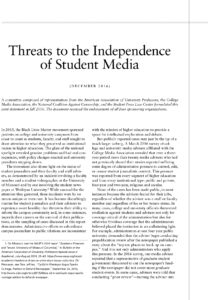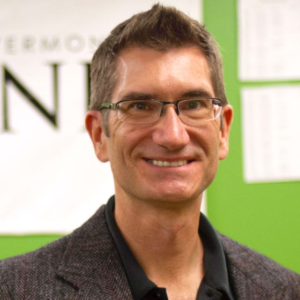Colleges urged to end retaliation against journalists and advisers
By Chris Evans
Chair, CMA First Amendment Advocacy Committee
Most advisers eventually get The Question.

It might come in a call or an email. Or a passing comment from a colleague in the hallway. Not infrequently, it first appears in the anxious look of an editor-in-chief who’s found herself on the receiving end of a tirade by a college administrator.
This particular question often serves as an opening salvo in a confrontation over something as frivolous as a bawdy sex column or as journalistically significant as an investigation into a provost’s drunken junket to Jamaica.
Whatever the content of the piece, top administrators want to know:
Why did you run that story?
Sometimes this question morphs into a command: Censor those students.
Or else.
It’s not hard to find accounts of advisers who have lost their positions, often over issues of student-generated content. A shortlist of the infamous institutions from just the past two years includes well-publicized cases at Mount St. Mary’s University in Maryland, Saint Peter’s University in New Jersey, Fairmont State University in West Virginia, Delta State University in Mississippi, Butler University in Indiana, Muscatine Community College in Iowa and Northern Michigan University.
These schools represent some of the best-known cases, but others exist. As chairman of CMA’s First Amendment Advocacy Committee, I regularly hear from advisers who want advice about how to handle hostile administrators; many of their cases never become public. In Spring 2016, I conducted an informal survey of CMA members: 20 media advisers revealed in the survey that they had been the target of administrative pressure to censor student content. Most said that they hadn’t gone public because they feared retribution. Some feared for their jobs.
These cases and others are addressed in the report that follows: a collaboration among CMA, the American Association of University Professors, the Student Press Law Center and the National Coalition Against Censorship. The report updates AAUP’s 1967 “Joint Statement on Rights and Freedoms of Students,” which championed independence for the student press during another turbulent time in our nation’s history.
This year’s report, released Dec. 1 by our four organizations and titled “Threats to the Independence of Student Media,” calls on the nation’s colleges to address the problems of censorship, retaliation and excessive secrecy that imperil the independent news coverage essential for civically healthy campuses.
The report, in part:
- Cites multiple cases in which college and university administrations exerted pressure in attempts to control, edit or censor student journalistic content. This pressure has been reported in every segment of higher education and every institutional type: public and private, four-year and two-year, religious and secular.
- Finds that administrative efforts to subordinate campus journalism to public relations concerns are inconsistent with the mission of higher education to foster intellectual exploration and debate.
- Notes that while journalism that discusses students’ dissatisfaction with the perceived shortcomings of their institutions can be uncomfortable, it fulfills an important civic function.
- Recommends curtailing the authority of campus public-relations offices to obstruct journalists’ access to decision-makers.
This year, with what seemed to be a wave of adviser firings and lesser punishments aimed at intimidating advisers for merely doing their jobs, members of all four organizations felt it essential to raise the alarm. CMA’s president, Kelley Lash, took the document to the CMA board this summer for approval. It passed unanimously.
“It’s so important for our organizations to speak with one voice on this issue, which impacts literally millions of educators and students,” Lash said. “College Media Association emphatically supports First Amendment freedoms for all student media at all institutions, both public and private, and agrees that these media must be free from all forms of external interference designed to influence content.
“Student media participants and their advisers should not be threatened or punished due to the content of student media. Their rights of free speech and free press must always be guaranteed.”
AAUP traditionally advocates for professors, but organization officials noted that staff members actually might have greater need of protection because, unlike professors, advisers who work as part of a student affairs department typically have no access to tenure.
“Even when they do not have formal faculty status, advisers to student media engage in instruction and therefore are entitled to the full protections of academic freedom as well as the freedom of the press,” said Henry Reichman, chairman of AAUP’s committee on academic freedom and tenure.
Joan Bertin, executive director of the anti-censorship coalition, emphasized the importance of students being able to learn without interference from college officials.
“It is critical for young people to understand First Amendment principles and their relationship to democracy,” Bertin said. “Ironically, some colleges and universities espouse support for press freedoms and free speech but deny students these rights in practice.
“This report exposes restrictions on press and speech freedoms on campus and exhorts college and university administrators to educate students in the operation of our constitutional system by allowing students to engage in its most critical functions: seeking information, becoming engaged and informed, and speaking out on matters of importance.”
In a period when fake news sometimes gets more traction than watchdog journalism, ensuring the independence of college media outlets is more important than ever, said Frank LoMonte, the SPLC executive director and a key author of the report.
Both students and advisers must be protected, he said.
“Being a journalism adviser is the only job that gets more dangerous the better you do it,” LoMonte said. “It is hypocritical for colleges to claim they support civic engagement while de-funding student news organizations, removing well-qualified faculty advisers and otherwise intimidating journalists into compliance.
“Colleges are more obsessed with promoting a favorable image than ever before, but a college that retaliates against students and faculty for unflattering journalism doesn’t just look bad: It is bad. We need a top-level commitment from the presidents of America’s colleges and universities to support editorially independent student-run news coverage, including secure funding and retaliation protection for students and their advisers.”
This report, a collaboration among all our organizations, is meant to shine a light on these urgent threats to student media.
I would hazard to say that most college administrators support student press freedoms. The lucky among us never hear The Question. But for those who do, we hope to speak with a united voice to provide a ready answer.
Why did you run that story?
I did not run that story. My students did. They ran that story because they felt that they had an important message to deliver and—to be clear—because they have the constitutional right to do so.

Chris Evans serves as chairman of CMA’s First Amendment Advocacy Committee, which seeks to help advisers under administrative pressure to control student content or otherwise violate students’ rights to free speech and free press. He teaches communication law and newswriting at the University of Vermont, where he advises The Vermont Cynic, WRUV-FM and UVMtv. He is a former newspaper reporter, fiction writer and returned Peace Corps volunteer.
